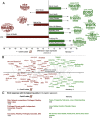The Cantril Ladder elicits thoughts about power and wealth
- PMID: 38302578
- PMCID: PMC10834405
- DOI: 10.1038/s41598-024-52939-y
The Cantril Ladder elicits thoughts about power and wealth
Abstract
The Cantril Ladder is among the most widely administered subjective well-being measures; every year, it is collected in 140+ countries in the Gallup World Poll and reported in the World Happiness Report. The measure asks respondents to evaluate their lives on a ladder from worst (bottom) to best (top). Prior work found Cantril Ladder scores sensitive to social comparison and to reflect one's relative position in the income distribution. To understand this, we explored how respondents interpret the Cantril Ladder. We analyzed word responses from 1581 UK adults and tested the impact of the (a) ladder imagery, (b) scale anchors of worst to best possible life, and c) bottom to top. Using three language analysis techniques (dictionary, topic, and word embeddings), we found that the Cantril Ladder framing emphasizes power and wealth over broader well-being and relationship concepts in comparison to the other study conditions. Further, altering the framings increased preferred scale levels from 8.4 to 8.9 (Cohen's d = 0.36). Introducing harmony as an anchor yielded the strongest divergence from the Cantril Ladder, reducing mentions of power and wealth topics the most (Cohen's d = -0.76). Our findings refine the understanding of historical Cantril Ladder data and may help guide the future evolution of well-being metrics and guidelines.
© 2024. The Author(s).
Conflict of interest statement
Oscar Kjell has co-founded a start-up using computational language assessments to diagnose mental health problems.
Figures





References
-
- Cantril H. The Pattern of Human Concerns. Rutgers University Press; 1965.
-
- Gallup. Understanding How Gallup Uses the Cantril Scale.http://www.gallup.com/poll/122453/understanding-gallup-uses-cantril-scal... (2011). Accessed 23 Apr 2011.
-
- Gallup . World Poll Methodology. Technical Report; 2019.
-
- Helliwell JF, Layard R, Sachs JD, De Neve J-E, Aknin LB, Wang S, editors. World Happiness Report 2023. Sustainable Development Solutions Network; 2023.
MeSH terms
Grants and funding
LinkOut - more resources
Full Text Sources

